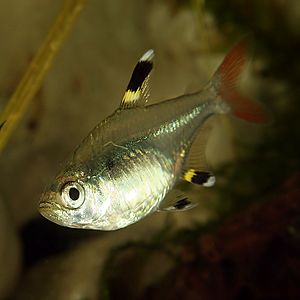Pristella maxillaris facts for kids
Quick facts for kids Pristella maxillaris |
|
|---|---|
 |
|
| Scientific classification | |
| Genus: |
Pristella
|
| Species: |
maxillaris
|
| Synonyms | |
|
|
The Pristella maxillaris is a type of fish known as a characin. It's often called the X-ray fish or X-ray tetra because its body is so clear you can almost see through it! Imagine seeing a fish that looks like an X-ray picture.
This amazing fish lives in many places. You can find it in the big Amazon and Orinoco river areas. It also lives in rivers along the coast of the Guianas. The X-ray fish can live in both acidic and alkaline waters. It can even handle a little bit of brackish water, which is a mix of fresh and salty water. Most other characins cannot do this.
X-ray fish are small, growing up to about 5 centimeters (2 inches) long. They like to live in large groups, called schools. Male X-ray fish are usually smaller and thinner than the females. Like many other tetras, they mostly eat tiny insects and small animals that float in the water.
What's in a Name?
You might hear the X-ray fish called by different names. Older books about fish often used the name Pristella riddlei. Today, many fish lovers call it the golden pristella tetra. Some still use X-ray tetra, which makes sense because of its clear body.
Other common names include goldfinch tetra. This name comes from the goldfinch bird, which has similar colors. People also just call it the pristella tetra, which is a shorter version of its scientific name. One old name, signal tetra, is not used much anymore. This name came from how its yellow and black top fin looked like a railway signal arm.
Keeping X-Ray Fish as Pets
The Pristella maxillaris is a great fish for a home aquarium. It's small and can adapt to different conditions. These fish will eat most types of fish food you give them. They are happy in water with a wide range of chemistry. This includes water with a pH from 6 to 8 and hardness up to 20 dGH.
Since X-ray fish are shoaling fish, they need to live in groups. You should keep at least six of them together. Make sure their tankmates are not aggressive or predatory fish. Otherwise, they are easy to keep in a community tank with other peaceful fish. A good size for their aquarium is at least 60 x 30 centimeters (about 15 gallons).
See also
 In Spanish: Pristella maxillaris para niños
In Spanish: Pristella maxillaris para niños

